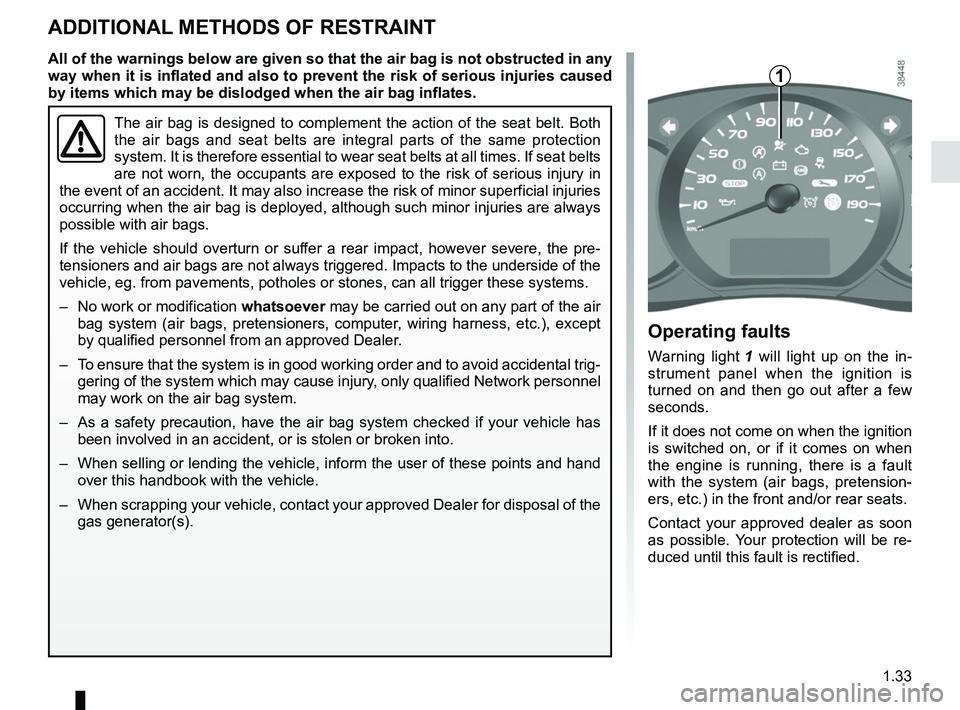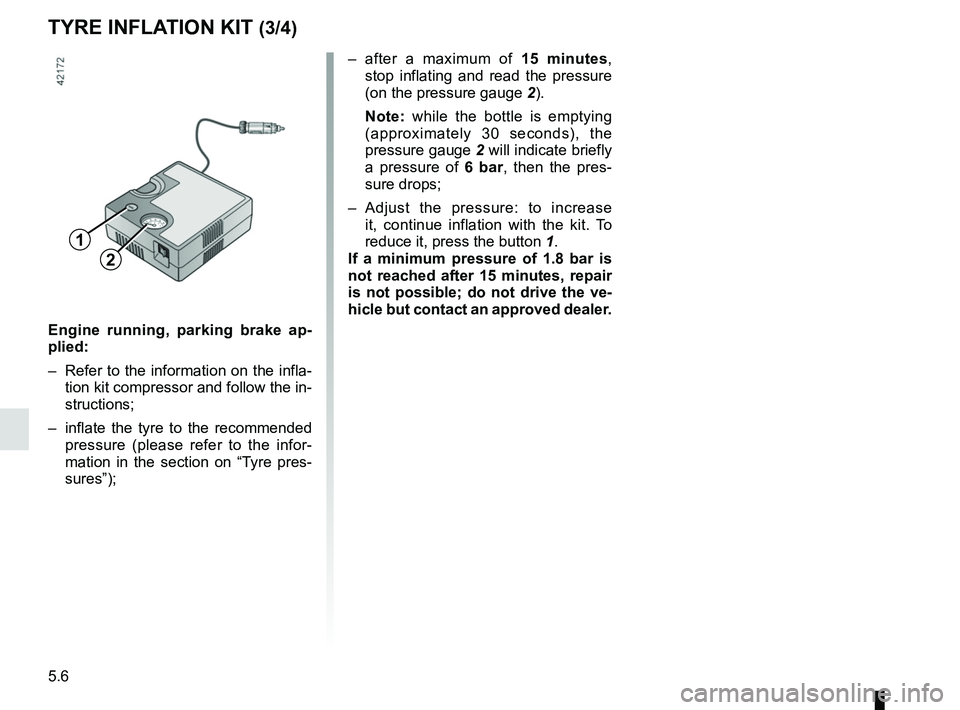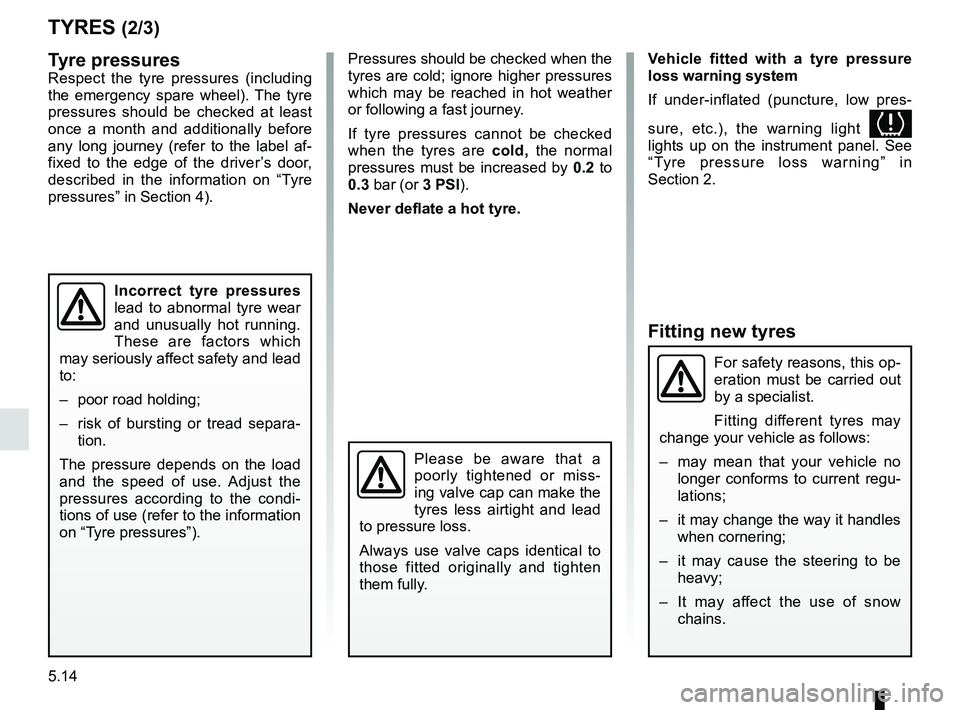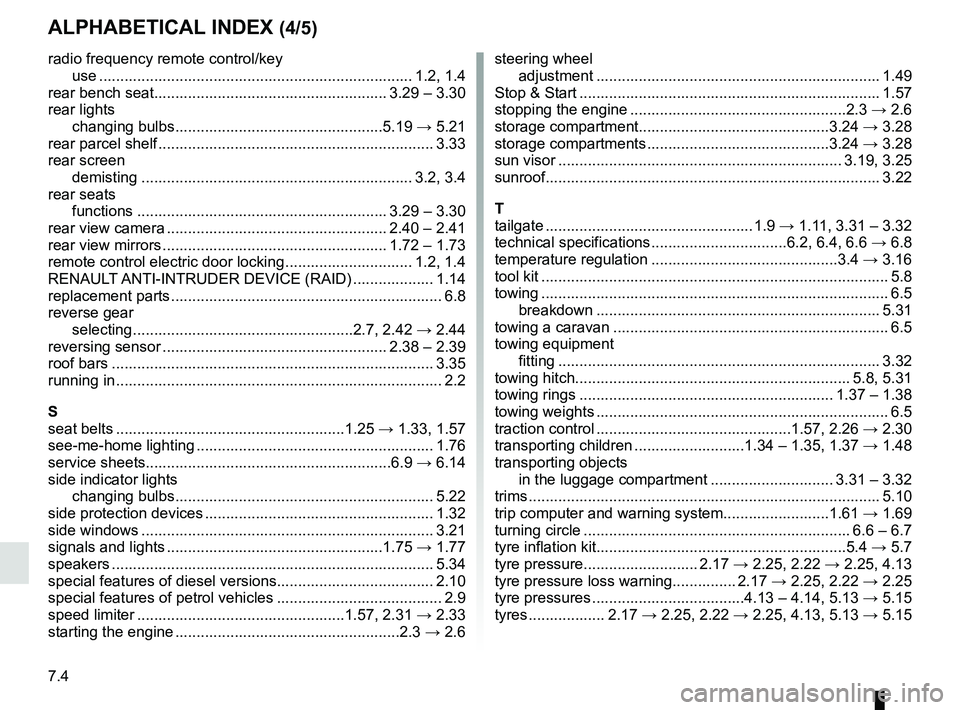run flat RENAULT KANGOO 2017 X61 / 2.G Owners Manual
[x] Cancel search | Manufacturer: RENAULT, Model Year: 2017, Model line: KANGOO, Model: RENAULT KANGOO 2017 X61 / 2.GPages: 260, PDF Size: 5.68 MB
Page 39 of 260

1.33
The air bag is designed to complement the action of the seat belt. Both \
the air bags and seat belts are integral parts of the same protection
system. It is therefore essential to wear seat belts at all times. If se\
at belts
are not worn, the occupants are exposed to the risk of serious injury in\
the event of an accident. It may also increase the risk of minor superfi\
cial injuries
occurring when the air bag is deployed, although such minor injuries are\
always
possible with air bags.
If the vehicle should overturn or suffer a rear impact, however severe, the pre-
tensioners and air bags are not always triggered. Impacts to the undersi\
de of the
vehicle, eg. from pavements, potholes or stones, can all trigger these s\
ystems.
– No work or modification whatsoever may be carried out on any part of the air
bag system (air bags, pretensioners, computer, wiring harness, etc.), except
by qualified personnel from an approved Dealer.
– To ensure that the system is in good working order and to avoid accidenta\
l trig- gering of the system which may cause injury, only qualified Network personnel
may work on the air bag system.
– As a safety precaution, have the air bag system checked if your vehicle \
has been involved in an accident, or is stolen or broken into.
– When selling or lending the vehicle, inform the user of these points and\
hand over this handbook with the vehicle.
– When scrapping your vehicle, contact your approved Dealer for disposal o\
f the gas generator(s).
ADDITIONAL METHODS OF RESTRAINT
Operating faults
Warning light 1 will light up on the in-
strument panel when the ignition is
turned on and then go out after a few
seconds.
If it does not come on when the ignition
is switched on, or if it comes on when
the engine is running, there is a fault
with the system (air bags, pretension-
ers, etc.) in the front and/or rear seats.
Contact your approved dealer as soon
as possible. Your protection will be re-
duced until this fault is rectified.
1
All of the warnings below are given so that the air bag is not obstructed in any
way when it is inflated and also to prevent the risk of serious injuries caused
by items which may be dislodged when the air bag inflates.
Page 198 of 260

5.6
– after a maximum of 15 minutes, stop inflating and read the pressure
(on the pressure gauge 2).
Note: while the bottle is emptying
(approximately 30 seconds), the
pressure gauge 2 will indicate briefly
a pressure of 6 bar, then the pres-
sure drops;
– Adjust the pressure: to increase it, continue inflation with the kit. To
reduce it, press the button 1.
If a minimum pressure of 1.8 bar is
not reached after 15 minutes, repair
is not possible; do not drive the ve-
hicle but contact an approved dealer.
Engine running, parking brake ap-
plied:
– Refer to the information on the infla- tion kit compressor and follow the in-
structions;
– inflate the tyre to the recommended pressure (please refer to the infor-
mation in the section on “Tyre pres-
sures”);
TYRE INFLATION KIT (3/4)
2
1
Page 206 of 260

5.14
Fitting new tyres
TYRES (2/3)
Pressures should be checked when the
tyres are cold; ignore higher pressures
which may be reached in hot weather
or following a fast journey.
If tyre pressures cannot be checked
when the tyres are cold, the normal
pressures must be increased by 0.2 to
0.3 bar (or 3 PSI).
Never deflate a hot tyre.Tyre pressuresRespect the tyre pressures (including
the emergency spare wheel). The tyre
pressures should be checked at least
once a month and additionally before
any long journey (refer to the label af-
fixed to the edge of the driver’s door,
described in the information on “Tyre
pressures” in Section 4).
Incorrect tyre pressures
lead to abnormal tyre wear
and unusually hot running.
These are factors which
may seriously affect safety and lead
to:
– poor road holding;
– risk of bursting or tread separa- tion.
The pressure depends on the load
and the speed of use. Adjust the
pressures according to the condi-
tions of use (refer to the information
on “Tyre pressures”).
Please be aware that a
poorly tightened or miss-
ing valve cap can make the
tyres less airtight and lead
to pressure loss.
Always use valve caps identical to
those fitted originally and tighten
them fully.
For safety reasons, this op-
eration must be carried out
by a specialist.
Fitting different tyres may
change your vehicle as follows:
– may mean that your vehicle no longer conforms to current regu-
lations;
– it may change the way it handles when cornering;
– it may cause the steering to be heavy;
– It may affect the use of snow chains.
Vehicle fitted with a tyre pressure
loss warning system
If under-inflated (puncture, low pres-
sure, etc.), the warning light
lights up on the instrument panel. See
“Tyre pressure loss warning” in
Section 2.
Page 256 of 260

7.4
ALPHABETICAL INDEX (4/5)
radio frequency remote control/keyuse ....................................................................\
...... 1.2, 1.4
rear bench seat....................................................... 3.29 – 3.30
rear lights changing bulbs .................................................5.19 → 5.21
rear parcel shelf ................................................................. 3.33
rear screen demisting ..............................................................\
.. 3.2, 3.4
rear seats functions ........................................................... 3.29 – 3.30
rear view camera .................................................... 2.40 – 2.41
rear view mirrors ..................................................... 1.72 – 1.73
remote control electric door locking .............................. 1.2, 1.4
RENAULT ANTI-INTRUDER DEVICE (RAID) ................... 1.14
replacement parts ................................................................ 6.8
reverse gear selecting ....................................................2.7, 2.42 → 2.44
reversing sensor ..................................................... 2.38 – 2.39
roof bars ........................................................................\
.... 3.35
running in ........................................................................\
..... 2.2
S
seat belts ......................................................1.25 → 1.33, 1.57
see-me-home lighting ........................................................ 1.76
service sheets..........................................................6.9 → 6.14
side indicator lights changing bulbs ............................................................. 5.22
side protection devices ...................................................... 1.32
side windows ..................................................................... 3.21
signals and lights ...................................................1.75 → 1.77
speakers ...............................................................\
............. 5.34
special features of diesel versions..................................... 2.10
special features of petrol vehicles ....................................... 2.9
speed limiter .................................................1.57, 2.31 → 2.33
starting the engine .....................................................2.3 → 2.6steering wheel
adjustment .............................................................\
...... 1.49
Stop & Start ....................................................................... 1.57
stopping the engine ...................................................2.3 → 2.6
storage compartment.............................................3.24 → 3.28
storage compartments ...........................................3.24 → 3.28
sun visor ................................................................... 3.19, 3.25
sunroof........................................................................\
....... 3.22
T
tailgate ................................................. 1.9 → 1.11, 3.31 – 3.32
technical specifications ................................6.2, 6.4, 6.6 → 6.8
temperature regulation ............................................3.4 → 3.16
tool kit ........................................................................\
.......... 5.8
towing .................................................................\
................. 6.5 breakdown ..............................................................\
..... 5.31
towing a caravan ................................................................. 6.5
towing equipment fitting ................................................................\
............ 3.32
towing hitch................................................................. 5.8, 5.31
towing rings ............................................................ 1.37 – 1.38
towing weights ..................................................................... 6.5
traction control ..............................................1.57, 2.26 → 2.30
transporting children ..........................1.34 – 1.35, 1.37 → 1.48
transporting objects in the luggage compartment ............................. 3.31 – 3.32
trims ..................................................................\
................. 5.10
trip computer and warning system.........................1.61 → 1.69
turning circle ............................................................... 6.6 – 6.7
tyre inflation kit...........................................................5.4 → 5.7
tyre pressure........................... 2.17 → 2.25, 2.22 → 2.25, 4.13
tyre pressure loss warning............... 2.17 → 2.25, 2.22 → 2.25
tyre pressures ....................................4.13 – 4.14, 5.13 → 5.15
tyres .................. 2.17 → 2.25, 2.22 → 2.25, 4.13, 5.13 → 5.15